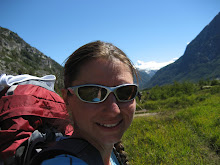How my trip played out and favorite parts.
Pictures are up on the link to the right - still need to label them. The Argentina pics are still upcoming - I've used my 100 MB quota, so they'll go up next month :)
Start of the trip..
Flew into Balmaceda Chile from Santiago. The flight between the two towns was amazingly beautiful. Had clear skies flying south with an endless view of mountains and lakes and dormant volcanoes.
The Balmaceda airport is super tiny. Took a shuttle van from Balmaceda to the nearest "bigger" town of Coyhaique Chile. And nope, wasn't riding on top of the bus with chickens and crying babies. It was actually fairly modern. Along the way pass little farm parcels and tiny little houses. I'm pretty much immediately in love.
Coyhaique was by far the fanciest (and biggest) town I was in the whole trip. Also one of the two places I was on paved roads :) It reminded me of a small-scale Boulder. About 40,000 people. Nice little downtown walking area with stores and restaurants and puppy dogs everywhere. I was amazed how "westernized" things were and how easy it was to get around. Everyone was super friendly. There were North Face stores and Patagonia stores, etc. Sporting equipment was key. People are dressed not so differently from here. Lots of happy kids and happy people and happy dogs everywhere. Lush open mountains in clear view (and walking distance). Fruit trees. Cute little houses. I stayed at a nice hotel here and met up with my main guide and travel partner, Manuel.
I've got a nice map that covers most of my ventures while I was down south.
From Coyhaique, traveled south with Manuel along the Sur (south/Hwy 7) highway for ~5 hours to a little (very little - 60 people) town of Puerta Bertrand. We did some grocery shopping in Coyhaique before we left, gearing up for our 8 day backpacking trip.
The drive south was lots of fun and beautiful. First heading out of town, noticed the burned trees, done to create more grazing land for the cattle and sheep. We were on paved roads for a short bit and then transitioned to dirt and gravel, of which I was on for most of the duration of my trip. People in Chile drive amazingly fast on the dirt roads, and they are windy and narrow. I loved the street signs marking inclines and declines in the road.
Getting closer to Puerta Bertrand caught my first glimpses of the amazingly blue-green water. To me, looked like the color of anti-freeze or blue kool-aid. The unusual color is a product of silica dioxide that causes the light to reflect and refract in a way that we see that color.
One of the biggest assets to Patagonia, next to the vast mountains and beautiful wild land, is the huge supply of fresh, drinkable water. While I was in Chile and Argentina, I drank almost solely from the rivers, streams, waterfalls, and glaciers, without any filtering. This is pretty amazing. Makes the land and area rich. I brought my camel bak, but only used it once in Argentina. Beyond that simply carried a water bottle and filled up whenever the need hit. I was a little leery at first, being that this is a big no-no in CO, but there is no giardia in Patagonia, and the fresh water source is so large, and animal and people population so low, the water is largely uncontaminated.
Precipitation comes in from the Pacific ocean, deposits on the Andes mountains forming the glaciers and ice caps. With the added weight the ice and snow shifts downwards (inland) and eventually melts forming the rivers and streams.
Subscribe to:
Post Comments (Atom)

No comments:
Post a Comment